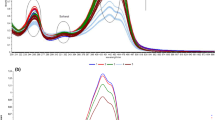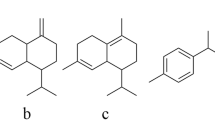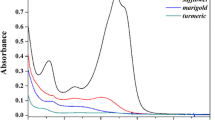Abstract
Introduction
The high market value of saffron (Crocus sativus L.) has made it an attractive candidate for adulteration. Safflower (Carthamus tinctorius L.) and tartrazine are among the most common herbal and synthetic foreign materials that may be added to pure saffron for the purpose of adulteration. In spite of encouraging advances achieved in the identification of adulteration in saffron samples, the lack of a simple method with sufficient power for discrimination of pure high grade saffron from meticulously adulterated saffron samples persuaded us to perform this study.
Objectives
In this work, we show that 1H NMR spectroscopy together with chemometric multivariate data analysis methods can be used for the detection of adulteration in saffron.
Methods
Authentic Iranian saffron samples (n = 20) and adulterated samples that were prepared by adding either different quantities of natural plant materials such as safflower, or synthetic dyes such as tartrazine or naphthol yellow to pure saffron (n = 22) composed the training set. This training set was used to build multivariate Principal Component Analysis (PCA) and Partial Least Squares Discriminant Analysis (PLS-DA) models. The predictive power of the PLS-DA model was validated by testing the model against an external dataset (n = 13).
Results
PCA and PLS-DA models could both discriminate between the authentic and adulterated samples, and the external validation showed 100% sensitivity and specificity for predicting the authenticity of suspicious samples. Peaks specific to authentic and adulterated samples were also characterized. Proximity of samples with unknown adulteration status to the samples adulterated with known compounds in the PCA provided insight regarding the identity of the adulterant in the suspicious samples. Furthermore, the authentic samples could be distinguished based on their cultivation site.
Conclusion
The present study demonstrates that the application of 1H NMR spectroscopy coupled with multivariate data analysis is a suitable approach for detection of adulteration in saffron specimens. Outstanding sensitivity and specificity of the PLS-DA model in discriminating the authentic from adulterated samples in external validation confirmed the high predictive power of the model. The advantage of the present method is its power for detecting a wide spectrum of adulterants, ranging from synthetic dyes to herbal materials, in a single assay.







Similar content being viewed by others
References
Abdullaev, F., & Espinosa-Aguirre, J. (2004). Biomedical properties of saffron and its potential use in cancer therapy and chemoprevention trials. Cancer Detection and Prevention, 28(6), 426–432.
Abe, K., & Saito, H. (2000). Effects of saffron extract and its constituent crocin on learning behaviour and long-term potentiation. Phytotheraphy Research, 14(3), 149–152.
Babaei, S., Talebi, M., & Bahar, M. (2014). Developing an SCAR and ITS reliable multiplex PCR-based assay for safflower adulterant detection in saffron samples. Food Control, 35(1), 323–328.
Beach, E. S., Malecky, R. T., Gil, R. R., Horwitz, C. P., & Collins, T. J. (2011). Fe-TAML/hydrogen peroxide degradation of concentrated solutions of the commercial azo dye tartrazine. Catalysis Science & Technology, 1(3), 437–443.
Cagliani, L. R., Culeddu, N., Chessa, M., & Consonni, R. (2015). NMR investigations for a quality assessment of Italian PDO saffron (Crocus sativus L.). Food Control, 50, 342–348.
Carmona, M., Zalacain, A., Sánchez, A. M., Novella, J. L., & Alonso, G. L. (2006). Crocetin esters, picrocrocin and its related compounds present in Crocus sativus stigmas and Gardenia jasminoides fruits. Tentative identification of seven new compounds by LC–ESI–MS. Journal of Agriculture and Food Chemistry, 54(3), 973–979.
Corti, P., Mazzei, E., Ferri, S., Franchi, G., & Dreassi, E. (1996). High Performance thin layer chromatographic quantitative analysis of picrocrocin and crocetin, active principles of saffron (Crocus sativus L.-Iridaceae): A new method. Phytochemical Analysis, 7(4), 201–203.
Dumas, M.-E., Maibaum, E. C., Teague, C., Ueshima, H., Zhou, B., Lindon, J. C., et al. (2006). Assessment of analytical reproducibility of 1 H NMR spectroscopy based metabonomics for large-scale epidemiological research: the INTERMAP Study. Analytical Chemistry, 78(7), 2199–2208.
Egdington, E. (1987). Randomization tests. New York: Marcel Dekker Inc.
Ellis, D. I., Brewster, V. L., Dunn, W. B., Allwood, J. W., Golovanov, A. P., & Goodacre, R. (2012). Fingerprinting food: Current technologies for the detection of food adulteration and contamination. Chemical Society Reviews, 41(17), 5706–5727.
Haghighi, B., Feizy, J., & Kakhki, A. H. (2007). LC determination of adulterated saffron prepared by adding styles colored with some natural colorants. Chromatographia, 66(5–6), 325–332.
Hausenblas, H. A., Saha, D., Dubyak, P. J., & Anton, S. D. (2013). Saffron (Crocus sativus L.) and major depressive disorder: a meta-analysis of randomized clinical trials. Journal of Integrative Medicine, 11(6), 377–383.
ISO3632-1 (2011). Spices-saffron (Crocus sativus L.) part 1: Specifications. Geneva: International Organization for Standardization.
ISO3632-2 (2010). Spices-saffron (Crocus sativus L.) part 2: Test methods. Geneva: International Organization for Standardization.
Jalali-Heravi, M., Parastar, H., & Ebrahimi-Najafabadi, H. (2009). Characterization of volatile components of Iranian saffron using factorial-based response surface modeling of ultrasonic extraction combined with gas chromatography–mass spectrometry analysis. Journal of Chromatography A, 1216(33), 6088–6097.
Johnson, R. (2014). Food Fraud and economically motivated adulteration of food and food ingredients. Washington, DC: Congressional Research Service Report. https://www.fas.org/sgp/crs/misc/R43358.pdf.
Karimi, S., Feizy, J., Mehrjo, F., & Farrokhnia, M. (2016). Detection and quantification of food colorant adulteration in saffron sample using chemometric analysis of FT-IR spectra. RSC Advances, 6(27), 23085–23093.
Kim, H. K., Choi, Y. H., & Verpoorte, R. (2010). NMR-based metabolomic analysis of plants. Nature Protocols, 5(3), 536–549.
Kumar, R., Singh, V., Devi, K., Sharma, M., Singh, M., & Ahuja, P. S. (2008). State of art of saffron (Crocus sativus L.) agronomy: A comprehensive review. Food Reviews International, 25(1), 44–85.
Lage, M., & Cantrell, C. L. (2009). Quantification of saffron (Crocus sativus L.) metabolites crocins, picrocrocin and safranal for quality determination of the spice grown under different environmental Moroccan conditions. Scientia Horticulturae, 121(3), 366–373.
Lee, E.-J., Shaykhutdinov, R., Weljie, A. M., Vogel, H. J., Facchini, P. J., Park, S.-U., et al. (2009). Quality assessment of ginseng by 1 H NMR metabolite fingerprinting and profiling analysis. Journal of Agriculture and Food Chemistry, 57(16), 7513–7522.
Lei, S., & Powers, R. (2013). NMR metabolomics analysis of Parkinson’s disease. Current Metabolomics, 1(3), 191–209.
Lopresti, A. L., & Drummond, P. D. (2014). Saffron (Crocus sativus) for depression: A systematic review of clinical studies and examination of underlying antidepressant mechanisms of action. Human Psychopharmacology: Clinical and Experimental, 29(6), 517–527.
Mannina, L., D’Imperio, M., Capitani, D., Rezzi, S., Guillou, C., Mavromoustakos, T., et al. (2009). 1 H NMR-based protocol for the detection of adulterations of refined olive oil with refined hazelnut oil. Journal of Agriculture and Food Chemistry, 57(24), 11550–11556.
Marieschi, M., Torelli, A., & Bruni, R. (2012). Quality control of saffron (Crocus sativus L.): Development of SCAR markers for the detection of plant adulterants used as bulking agents. Journal of Agriculture and Food Chemistry, 60(44), 10998–11004.
Markley, J. L., Brüschweiler, R., Edison, A. S., Eghbalnia, H. R., Powers, R., Raftery, D., et al. (2017). The future of NMR-based metabolomics. Current Opinion in Biotechnology, 43, 34–40.
Mazzola, E. P., Bell, S. J., Turujman, S. A., Barrows, J. N., Bailey, J., McMahon, J. B., et al. (1999). Nuclear magnetic resonance investigations of azo-hydrazone, acid-base equilibria of FD&C yellow no. 5 (tartrazine). Canadian Journal of Chemistry, 77(11), 1941–1945.
Ordoudi, S. A., Cagliani, L. R., Lalou, S., Naziri, E., Tsimidou, M. Z., & Consonni, R. (2015). 1 H NMR-based metabolomics of saffron reveals markers for its quality deterioration. Food Research International, 70, 1–6.
Petrakis, E. A., Cagliani, L. R., Polissiou, M. G., & Consonni, R. (2015). Evaluation of saffron (Crocus sativus L.) adulteration with plant adulterants by 1 H NMR metabolite fingerprinting. Food Chemistry, 173, 890–896.
Sabatino, L., Scordino, M., Gargano, M., Belligno, A., Traulo, P., & Gagliano, G. (2011). HPLC/PDA/ESI-MS evaluation of saffron (Crocus sativus L.) adulteration. Natural Products Communications, 6(12), 1873–1876.
Schreier, C., Kremer, W., Huber, F., Neumann, S., Pagel, P., Lienemann, K., et al. (2013). Reproducibility of NMR analysis of urine samples: Impact of sample preparation, storage conditions, and animal health status. BioMed Research International, 2013, 878374. doi:10.1155/2013/878374.
SIMCA (2015). User guide and tutorial, version 14.0. Umea: Umetrics AB.
Sobolev, A. P., Carradori, S., Capitani, D., Vista, S., Trella, A., Marini, F., et al. (2014). Saffron samples of different origin: An NMR study of microwave-assisted extracts. Foods, 3(3), 403–419.
Sumner, L. W., Amberg, A., Barrett, D., Beale, M. H., Beger, R., Daykin, C. A., et al. (2007). Proposed minimum reporting standards for chemical analysis. Metabolomics, 3(3), 211–221.
Tarantilis, P. A., & Polissiou, M. G. (1997). Isolation and identification of the aroma components from saffron (Crocus sativus). Journal of Agriculture and Food Chemistry, 45(2), 459–462.
Torelli, A., Marieschi, M., & Bruni, R. (2014). Authentication of saffron (Crocus sativus L.) in different processed, retail products by means of SCAR markers. Food Control, 36(1), 126–131.
Van Calsteren, M.-R., Bissonnette, M. C., Cormier, F., Dufresne, C., Ichi, T., LeBlanc, J. Y., et al. (1997). Spectroscopic characterization of crocetin derivatives from Crocus sativus and Gardenia jasminoides. Journal of Agriculture and Food Chemistry, 45(4), 1055–1061.
van der Kooy, F., Maltese, F., Choi, Y. H., Kim, H. K., & Verpoorte, R. (2009). Quality control of herbal material and phytopharmaceuticals with MS and NMR based metabolic fingerprinting. Planta Medica, 75(7), 763–775.
Villa, C., Costa, J., Meira, L., Oliveira, M. B. P., & Mafra, I. (2016). Exploiting DNA mini-barcodes as molecular markers to authenticate saffron (Crocus sativus L.). Food Control, 65, 21–31.
Vogels, J. T., Terwel, L., Tas, A. C., van den Berg, F., Dukel, F., & van der Greef, J. (1996). Detection of adulteration in orange juices by a new screening method using proton NMR spectroscopy in combination with pattern recognition techniques. Journal of Agriculture and Food Chemistry, 44(1), 175–180.
Whang, W. K., Lee, M., & Choi, H. (2007). Metabolic discrimination of safflower petals of various origins using 1H NMR spectroscopy and multivariate statistical analysis. Bulletin-Korean Chemical Society, 28(4), 557–560.
Winterhalter, P., & Straubinger, M. (2000). Saffron—renewed interest in an ancient spice. Food Reviews International, 16(1), 39–59.
Yilmaz, A., Nyberg, N. T., Mølgaard, P., Asili, J., & Jaroszewski, J. W. (2010). 1 H NMR metabolic fingerprinting of saffron extracts. Metabolomics, 6(4), 511–517.
Zalacain, A., Ordoudi, S., Blazquez, I., Díaz-Plaza, E. M., Carmona, M., Tsimidou, M., et al. (2005). Screening method for the detection of artificial colours in saffron using derivative UV–Vis spectrometry after precipitation of crocetin. Food Additives and Contaminants, 22(7), 607–615.
Acknowledgements
This study was supported by the Armstrong Chair in Molecular Cancer Epidemiology Research (to HJV), which in turn is funded by the Alberta Cancer Foundation. RD was supported by the Faculty of Pharmacy and the Research Council of Tehran University of Medical Sciences.
Author information
Authors and Affiliations
Corresponding author
Ethics declarations
Conflict of interest
All authors declare that they have no conflict of interest.
Ethical approval
This article does not contain any studies with human participants or animals performed by any of the authors.
Electronic supplementary material
Below is the link to the electronic supplementary material.
Rights and permissions
About this article
Cite this article
Dowlatabadi, R., Farshidfar, F., Zare, Z. et al. Detection of adulteration in Iranian saffron samples by 1H NMR spectroscopy and multivariate data analysis techniques. Metabolomics 13, 19 (2017). https://doi.org/10.1007/s11306-016-1155-x
Received:
Accepted:
Published:
DOI: https://doi.org/10.1007/s11306-016-1155-x




